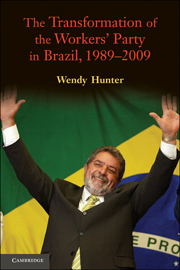Book contents
- Frontmatter
- Contents
- Tables, Charts, and Figure in Text
- Tables and Chart in the Appendix
- Acronyms
- Acknowledgments
- 1 Introduction: Understanding the Normalization of the Workers' Party
- 2 Strategic Change or Organizational Persistence? Evolution of the Workers' Party
- 3 Opposition Politics: The PT in the Chamber of Deputies
- 4 The PT in Municipal Government: The Pragmatic Face of the Party
- 5 Striving for the Presidency: From Opposition to Government
- 6 New Challenges and Opportunities: The PT in Government, 2003–2009
- 7 Analytical Implications and Comparative Perspectives
- Appendix
- References
- Interviews
- Index
5 - Striving for the Presidency: From Opposition to Government
Published online by Cambridge University Press: 05 June 2012
- Frontmatter
- Contents
- Tables, Charts, and Figure in Text
- Tables and Chart in the Appendix
- Acronyms
- Acknowledgments
- 1 Introduction: Understanding the Normalization of the Workers' Party
- 2 Strategic Change or Organizational Persistence? Evolution of the Workers' Party
- 3 Opposition Politics: The PT in the Chamber of Deputies
- 4 The PT in Municipal Government: The Pragmatic Face of the Party
- 5 Striving for the Presidency: From Opposition to Government
- 6 New Challenges and Opportunities: The PT in Government, 2003–2009
- 7 Analytical Implications and Comparative Perspectives
- Appendix
- References
- Interviews
- Index
Summary
This chapter examines and analyzes Lula's first four presidential contests and their effects on the party's trajectory. The PT's determination to place Lula in the presidency, coupled with Lula's fierce personal ambition to become president, played a decisive role in pushing the PT in a more catchall direction over time. The party made a number of important programmatic and organizational changes designed to broaden Lula's electoral appeal and empower the moderate factions that backed him. A key institutional constraint – namely the need to win a majority of votes to capture the presidency – made it all the more imperative to extend Lula's electoral reach across broad segments of the electorate, many of which did not respond positively to the party's early radicalism. A decline in Brazil's economic and political volatility after the enactment of the Plano Real – that is, better governance and growing state and party institutionalization – rendered a far-left strategy much less likely to be successful than it previously was. Changes the party enacted in response to Lula's first three failed bids (1989, 1994, and 1998) were crucial in securing his ultimate triumph in 2002. The factors responsible for the party's adaptation in the context of Lula's attempts to win presidential office fit well into a strategic framework. Indeed, rational choice institutionalism sheds crucial light on how politics in the presidential arena pushed the party in a more pragmatic direction over time.
- Type
- Chapter
- Information
- The Transformation of the Workers' Party in Brazil, 1989–2009 , pp. 106 - 145Publisher: Cambridge University PressPrint publication year: 2010

